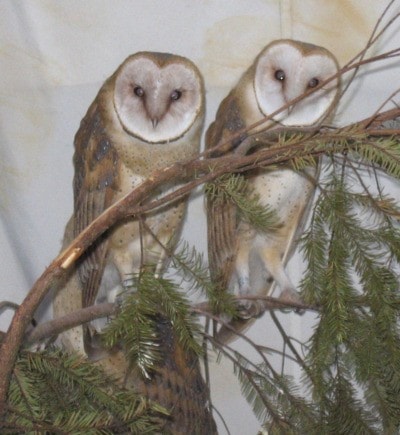One of the most mysterious and fascinating owl species is also one of the oldest.
The barn owl is part of the "Tytonidae" family, fossilized remains have dated them back between 12 and 20 million years and they have many unique features that are not found in any other owl species.
Also known as the "sweetheart" owl, barn owls are the only owl with heart-shaped faces and black, almond-shaped eyes. Barn owls are medium-sized and are stunningly beautiful with slender bodies and long legs.
Their plumage is a great example of "counter shading," an adaptation used for concealment. The male has whiter facial disks and breast plumage than the female, which is larger and has more richly tinged buffy brown breast feathers flecked with darker spots.
Both sexes have dark grey brown backs and wings, which allows them to take full advantage of the interplay between light and dark enabling them to "disappear" as they change direction in flight.
Probably one of the best-known owls they are distributed worldwide with the exception of Antarctica. In British Columbia they are only found in southern coastal valleys including Vancouver Island; they are also found in southern Ontario where they are considered to be an endangered species.
Until the early 1900s barn owls were not found in southern Canada as they cannot survive in freezing temperatures; with the development of agricultural land and the building of farms they gradually adapted to the winters seeking shelter in barns or other abandoned buildings.
Barn owls are poorly adapted to freezing temperatures, their long legs are lightly feathered, and their body plumage is thin, their fat reserves scant. When nights drop below freezing these owls will stay warm by crouching over and sitting on their legs or stand on one foot tucking the other into their warm belly feathers.
Birds do not have sweat glands or pores to help cool their bodies in the heat so they have a built in cooling system; increased blood flow to the most exposed areas such as feet or beaks allows excess heat to evaporate cooling them down.
In addition, owls cool themselves by panting like a dog together with "gular fluttering," which is the rapid vibration of the upper throat muscles increasing moisture and evaporation from the throat and mouth.
Barn owls are very secretive, nocturnal owls with remarkable hearing out shining all other owl species with their ability to pinpoint prey in complete darkness.
Their facial disk feathers are pulled forward, exposing asymmetrical ear opening that are as large as humans' ears, the sounds are then channelled into the ears; all other owls use a combination of eyesight and hearing to locate prey.
Favourite food for barn owls are field mice and rodents, but they will also prey on rats and have become invaluable to farmers as they can consume multiple rodents in one night and keep the rodent population under control.
Usual habitat for these owls is open farmland with barns or other abandoned buildings but they will also shelter in caves or on cliffs and have adapted to urban areas and even use manmade nest boxes.
Barn owls are very infrequent visitors to MARS and usually the rescue calls are from farmers who find them in barns so it was very surprising to be called to a residential home in Comox. Ash and Sooty, a mated pair of barn owls for reasons only known to them decided to play Santa and go down the chimney.
Perhaps seeking shelter and warmth during the last cold spell, or looking for a cosy nest site they entered the chimney but were unable to go back up and landed in the hearth of a fireplace.
Fortunately for them and the homeowners the fireplace had glass doors and a screen, which prevented the owls from creating a mess in the living room. The two owls were snuggled together covered in soot and ash and did not put up a struggle when removed from the fireplace.
Ash, the female, was having considerable breathing difficulties either from soot inhalation or stress, but Sooty did not appear to be in any acute distress. Both owls were put in an incubator with a humidifier to help them breathe.
They have now been relocated to an outside aviary complete with a nest box in case Ash is carrying eggs. Both are eating and gaining weight.
If any farmers in the Comox area around the Dyke Road are interested in adopting these owls into a barn, contact us at 250-337-2021.
This is a great reminder to homeowners who have open chimneys to make sure you have a grate or screen on top of the opening as not only owls but starlings' and chimney swifts may also come looking for a warm sheltered spot and they can create havoc if they nest or find their way into your living area.
To follow the owls' progress or updates on other patients please check www.wingtips.org. For all other calls 250-337-2021, to report injured wildlife 1-800-304-9968.
Sandy Fairfield is the educational co-ordinator for the Mountainaire Avian Rescue Society (MARS). The MARS column appears every second Friday.
